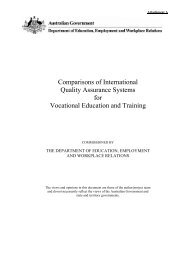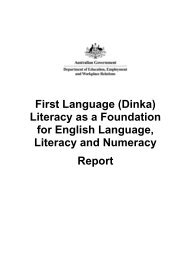National Survey of Research Commercialisation - Australian ...
National Survey of Research Commercialisation - Australian ...
National Survey of Research Commercialisation - Australian ...
Create successful ePaper yourself
Turn your PDF publications into a flip-book with our unique Google optimized e-Paper software.
NATIONAL SURVEY OF RESEARCH COMMERCIALISATION<br />
by the Organisation for Economic Cooperation and Development (OECD). The PPPs<br />
used were:<br />
Australia 1.320<br />
Canada 1.208<br />
USA 1.000<br />
The reader should note that there are some variations in the scope <strong>of</strong> research<br />
expenditure reported by institutions in the three countries. For a summary <strong>of</strong> those<br />
variations, the reader is referred to the OECD publication, Main Science and Technology<br />
Indicators 2002/1 (OECD, 2002). In particular, the scope <strong>of</strong> research expenditure data<br />
reported by institutions in Australia and Canada appears to be wider than that for data<br />
reported by institutions in the USA.<br />
Country comparisons were made also on the basis <strong>of</strong> ratios <strong>of</strong> each <strong>of</strong> the four<br />
indicators to gross domestic product (GDP), as a way <strong>of</strong> adjusting absolute levels<br />
<strong>of</strong> commercialisation activity in the four areas in the three countries relative to the<br />
magnitude <strong>of</strong> overall economic output in those countries.<br />
Figures for GDP in 2000 for the three countries were sourced from the OECD’s Main<br />
Science and Technology Indicators 2002/1(OECD, 2002). For each country, the figure for<br />
GDP that was used for comparative purposes was that expressed in US dollars on the<br />
basis <strong>of</strong> the purchasing power parities referred to above.<br />
To account for the fact that, in each country, the four indicators <strong>of</strong> commercialisation<br />
reflect only samples <strong>of</strong> the overall level <strong>of</strong> activity, and that these samples vary in size<br />
from country to country, GDP was, in each case, multiplied by a factor that embodied<br />
the response rate <strong>of</strong> institutions in each country relative to the response rate <strong>of</strong> US<br />
institutions, as follows:<br />
Respondents Response rate Adjustment factor<br />
Australia 49 78% (A) 0.77 (=B/A)<br />
USA 167 60% (B) 1.00 (=B/B)<br />
Canada 22 44% (C) 1.36 (=B/C)<br />
This adjustment was not necessary in the case <strong>of</strong> research expenditure, since the<br />
expenditures used in the calculation <strong>of</strong> ratios for the comparisons was only that <strong>of</strong> the<br />
respondent institutions in each <strong>of</strong> the three countries.<br />
The reader should note that the assumption that underlies the adjustment made to GDP<br />
is that the samples <strong>of</strong> institutions for the three countries are equally representative <strong>of</strong><br />
the level <strong>of</strong> commercial activity <strong>of</strong> institutions that were the subject <strong>of</strong> the surveys. This<br />
might not be the case.<br />
For the comparisons <strong>of</strong> adjusted gross income from licences, amounts <strong>of</strong> income were<br />
adjusted using the PPPs and are expressed in US dollars.<br />
40

















